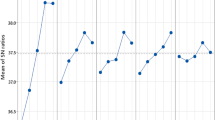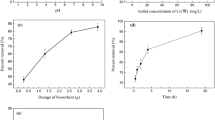Abstract
How to effectively remove excess Sb(III) in the water environment by biosorption is receiving close attention in the international scientific community. To obtain the maximum biosorption efficiency, response surface methodology (RSM) was employed to optimize a total of 13 factors for biosorption of Sb(III) onto living Rhodotorula mucilaginosa DJHN070401. The mechanism of biosorption and bioaccumulation was also studied. The results showed that biosorption reached 56.83% under the optimum conditions. Besides, pH, Fe2+, and temperature are significant influencing factors, and control of Ca2+ and Fe2+ has a beneficial impact on Sb(III) biosorption. The characterization explained that physical adsorption occurred readily on the loose and porous surface of DJHN070401 where carboxyl, amidogen, phosphate group, and polysaccharide C-O functional groups facilitated absorption by complexation with Sb(III), accompanied by ion exchange of Na+, Ca2+ ions with Sb(III). It was also noted that the living cell not only improved the removal efficiency in the presence of metabolic inhibitors but also prevented intracellular Sb(III) being re-released into the environment. The results of this study underpin improved and efficient methodology for biosorption of Sb(III) from wastewater.





Similar content being viewed by others
References
Herath I, Vithanage M, Bundschuh J (2017) Antimony as a global dilemma: geochemistry, mobility, fate and transport. Environ Pollut 223:545–549. https://doi.org/10.1016/j.envpol.2017.01.057
Henckens MLCM, Driessen PPJ, Worrell E (2016) How can we adapt to geological scarcity of antimony? Investigation of antimony's substitutability and of other measures to achieve a sustainable use. Resour Conserv Recy 108:54–62. https://doi.org/10.1016/j.resconrec.2016.01.012
Macgregor K, Mackinnon G, Farmer JG et al (2015) Mobility of antimony, arsenic and lead at a former antimony mine, Glendinning, Scotland. Sci Total Environ 529:213–222. https://doi.org/10.1016/j.scitotenv.2015.04.039
He MC, Wang XQ, Wu FC et al (2012) Antimony pollution in China. Sci Total Environ 421–422:41–50. https://doi.org/10.1016/j.scitotenv.2011.06.009
Ungureanu G, Santos S, Boaventura R et al (2015) Arsenic and antimony in water and wastewater: overview of removal techniques with special reference to latest advances in adsorption. J Environ Manage 151:326–342. https://doi.org/10.1016/j.jenvman.2014.12.051
Li JY, Zheng BH, He YZ et al (2018) Antimony contamination, consequences and removal techniques: a review. Ecotox Environ Safe 156:125–134. https://doi.org/10.1016/j.ecoenv.2018.03.024
Vijayaraghavan K, Balasubramanian R (2011) Antimonite Removal Using Marine Algal Species. Ind Eng Chem Res 50(17):9864–9869. https://doi.org/10.1021/ie200776m
Urík M, Polák F, Bujdoš M et al (2019) Antimony leaching from antimony-bearing ferric oxyhydroxides by filamentous fungi and biotransformation of ferric substrate. Sci Total Environ 664:683–689. https://doi.org/10.1016/j.scitotenv.2019.02.033
He JS, Chen JP (2014) A comprehensive review on biosorption of heavy metals by algal biomass: materials, performances, chemistry, and modeling simulation tools. Bioresour Technol 160(6):67–78. https://doi.org/10.1016/j.biortech.2014.01.068
Banerjee A, Sarkar P, Banerjee S (2016) Application of statistical design of experiments for optimization of As(V) biosorption by immobilized bacterial biomass. Ecol Eng 86:13–23. https://doi.org/10.1016/j.ecoleng.2015.10.015
Sun WM, Xiao EZ, Kalin M et al (2016) Remediation of antimony-rich mine waters: assessment of antimony removal and shifts in the microbial community of an onsite field-scale bioreactor. Environ Pollut 215(2):213–222. https://doi.org/10.1016/j.envpol.2016.05.008
Lialikova NN (1974) Stibiobacter senarmontii-a new microorganism oxidizing antimony. Mikrobiologiya 43(6):941–948
Li YC, Wu JX, Hu W et al (2018) A mechanistic analysis of the influence of iron-oxidizing bacteria on antimony(V) removal from water by microscale zero valent iron. J Chem Technol Biot 93:2527–2534. https://doi.org/10.1002/jctb.5606
Wang HW, Chen FL, Mu SY et al (2013) Removal of antimony(Sb(V)) from Sb mine drainage: biological sulfate reduction and sulfide oxidation-precipitation. Bioresour Technol 146(10):799–802. https://doi.org/10.1016/j.biortech.2013.08.002
Zhang GP, Ouyang XX, Li HX et al (2016) Bioremoval of antimony from contaminated waters by a mixed batch culture of sulfate-reducing bacteria. Int Biodeter Biodegr 115(12):148–155. https://doi.org/10.1016/j.ibiod.2016.08.007
Wan CL, Wang L, Lee DJ et al (2014) Fungi aerobic granules and use of Fe(III)-treated granules for biosorption of antimony(V). J Taiwan Inst Chem E 45(5):2610–2614. https://doi.org/10.1016/j.jtice.2014.06.019
Wang L, Wan CL, Lee DJ et al (2014) Biosorption of antimony(V) onto Fe(III)-treated aerobic granules. Bioresour Technol 158(2):351–354. https://doi.org/10.1016/j.biortech.2014.02.046
Li XJ, Chen P, Chen CL et al (2013) Bacillus sp treatment of wastewater containing antimony. Agr Sci Technol 14(9):1347–1351. https://doi.org/10.16175/j.cnki.1009-4229.2013.09.006
Wu FC, Sun FH, Wu S et al (2012) Removal of antimony(III) from aqueous solution by freshwater cyanobacteria Microcystis biomass. Chem Eng J 183(4):172–179. https://doi.org/10.1016/j.cej.2011.12.050
Li J, Wang Q, Zhang SZ et al (2013) Phylogenetic and genome analyses of antimony-oxidizing bacteria isolated from antimony mined soil. Int Biodeter Biodegr 76:76–80. https://doi.org/10.1016/j.ibiod.2012.06.009
Nguyen VK, Choi WY, Yu J et al (2017) Microbial oxidation of antimonite and arsenite by bacteria isolated from antimony-contaminated soils. Int J Hydrogen Energ 42(45):27832–27842. https://doi.org/10.1016/j.ijhydene.2017.08.056
Yu C, Tang X, Li LS et al (2019) The long-term effects of hexavalent chromium on anaerobic ammonium oxidation process: performance inhibition, hexavalent chromium reduction and unexpected nitrite oxidation. Bioresour Technol 283:138–147. https://doi.org/10.1016/j.biortech.2019.03.081
Jaafari J, Yaghmaeian K (2019) Optimization of heavy metal biosorption onto freshwater algae (Chlorella coloniales) using response surface methodology (RSM). Chemosphere 217:447–455. https://doi.org/10.1016/j.chemosphere.2018.10.205
Reddy LVA, Wee YJ, Yun JS et al (2008) Optimization of alkaline protease production by batch culture of Bacillus sp RKY3 through Plackett-Burman and response surface methodological approaches. Bioresour Technol 99(7):2242–2249. https://doi.org/10.1016/j.biortech.2007.05.006
Uluozlu OD, Sarı A, Tuzen M (2010) Biosorption of antimony from aqueous solution by lichen (Physcia tribacia). Chem Eng J 163(3):382–388. https://doi.org/10.1016/j.cej.2010.08.022
Mittal VK, Bera S, Narasimhan SV et al (2013) Adsorption behavior of antimony(III) oxyanions on magnetite surface in aqueous acid environment. Appl Surf Sci 266(2):272–279. https://doi.org/10.1016/j.apsusc.2012.12.010
Guo XJ, Wu ZJ, He MC et al (2014) Adsorption of antimony onto iron oxyhydroxides: adsorption behavior and surface. J Hazard Mater 276(9):339–345. https://doi.org/10.1016/j.jhazmat.2014.05.025
Luo SL, Xiao X, Xi Q et al (2011) Enhancement of cadmium bioremediation by endophytic bacterium Bacillus sp. L14 using industrially used metabolic inhibitors (DCC or DNP). J Hazard Mater 190(1–3):1079–1082. https://doi.org/10.1016/j.jhazmat.2011.04.023
Bhosale P, Gadre RV (2001) Production of β-carotene by a Rhodotorula glutinis mutant in sea water medium. Bioresour Technol 76(1):53–55. https://doi.org/10.1016/S0960-8524(00)00075-4
Bhagwat PK, Jhample SB, Dandge PB (2015) Statistical medium optimization for the production of collagenolytic protease by Pseudomonas sp. SUK using response surface methodology Microbiology 84(4):520–530. https://doi.org/10.1134/S0026261715040037
Xi JH, He MC, Lin CY et al (2011) Adsorption of antimony(III) and antimony(V) on bentonite: kinetics, thermodynamics and anion competition. Microchem J 97(1):85–91. https://doi.org/10.1016/j.microc.2010.05.017
Shin YM, Kwon TH, Kim KS et al (2001) Enhanced iron uptake of Saccharomyces cerevisiae by heterologous expression of a tadpole ferritin gene. Appl Environ Microb 67(3):1280–1283. https://doi.org/10.1128/AEM.67.3.1280-1283.2001
Huang F, Dang Z, Guo CL et al (2013) Biosorption of Cd(II) by live and dead cells of Bacillus cereus RC-1 isolated from cadmium-contaminated soil. Colloid Surface B 107:11–18. https://doi.org/10.1016/j.colsurfb.2013.01.062
Guo HJ, Luo SL, Chen L et al (2010) Bioremediation of heavy metals by growing hyperaccumulaor endophytic bacterium Bacillus sp L14. Bioresour Technol 101(2):8599–8605. https://doi.org/10.1016/j.biortech.2010.06.085
Ucun H, Bayhan YK, Kaya Y et al (2002) Biosorption of chromium(VI) from aqueous solution by cone biomass of Pinus Sylvestris. Bioresour Technol 85(2):155–158. https://doi.org/10.1016/S0960-8524(02)00086-X
Milová-žiaková B, Urík M, Boriová K et al (2016) Fungal solubilization of manganese oxide and its significance for antimony mobility. Int Biodeter Biodegr 114:157–163. https://doi.org/10.1016/j.ibiod.2016.06.011
Pan CM, Fan YT, Xing Y et al (2008) Statistical optimization of process parameters on biohydrogen production from glucose by Clostridium sp. Fanp2. Bioresour Technol 99(8):3146–3154. https://doi.org/10.1016/j.biortech.2007.05.055
Li XD, Jia R, Li PS et al (2009) Response surface analysis for enzymatic decolorization of Congo red by manganese peroxidase. J Mol Catal B-Enzym 56(1):1–6. https://doi.org/10.1016/j.molcatb.2008.03.013
Wang HY, He YJ, Chai LY et al (2019) Highly-dispersed Fe2O3@C electrode materials for Pb2+ removal by capacitive deionization. Carbon 153:12–20. https://doi.org/10.1016/j.carbon.2019.06.066
Iqbal M, Saeed A, Edyvean RGJ (2013) Bioremoval of antimony(III) from contaminated water using several plant wastes: optimization of batch and dynamic flow conditions for sorption by green bean husk (Vigna radiata). Chem Eng J 225(3):192–201. https://doi.org/10.1016/j.cej.2013.03.079
Sun FH, Wu FC, Liao HQ et al (2011) Biosorption of antimony(V) by freshwater cyanobacteria Microcystis biomass: chemical modification and biosorption mechanisms. Chem Eng J 171(3):1082–1090. https://doi.org/10.1016/j.cej.2011.05.004
Guan XH, Ma J, Dong HR et al (2009) Removal of arsenic from water: effects of competing anions on As(III) removal in KMnO4-Fe(II) process. Water Res 43(15):3891–3899. https://doi.org/10.1016/j.watres.2009.06.008
Anand P, Isar J, Saran S et al (2006) Bioaccumulation of copper by Trichoderma viride. Bioresour Technol 97(8):1018–1025. https://doi.org/10.1016/j.biortech.2005.04.046
Tella M, Pokrovski GS (2009) Antimony(III) complexing with O-bearing organic ligands in aqueous solution: an X-ray absorption fine structure spectroscopy and potentiometric study. Geochim Cosmochim AC 73(2):268–290. https://doi.org/10.1016/j.gca.2008.10.014
Huang F, Guo CL, Lu GN et al (2014) Bioaccumulation characterization of cadmium by growing Bacillus cereus RC-1 and its mechanism. Chemosphere 109:134–142. https://doi.org/10.1016/j.chemosphere.2014.01.066
Lin YB, Wang XY, Wang BP et al (2012) Bioaccumulation characterization of zinc and cadmium by Streptomyces zinciresistens, a novel actinomycete. Ecotox Environ Safe 77:7–17. https://doi.org/10.1016/j.ecoenv.2011.09.016
Miao YY, Han FC, Pan BC et al (2014) Antimony(V) removal from water by hydrated ferric oxides supported by calcite sand and polymeric anion exchanger. J Environ Sci 26(2):307–314. https://doi.org/10.1016/S1001-0742(13)60418-0
Xiao X, Luo SL, Zeng GM et al (2010) Biosorption of cadmium by endophytic fungus (EF) Microsphaeropsis sp. LSE10 isolated from cadmium hyperaccumulator Solanum nigrum L. Bioresour Technol 101(6):1668–1674. https://doi.org/10.1016/j.biortech.2009.09.083
Radhika V, Subramanian S, Natarajan KA (2006) Bioremediation of zinc using Desulfotomaculum nigrificans: bioprecipitation and characterization studies. Water Res 40(19):3628–3636. https://doi.org/10.1016/j.watres.2006.06.013
Malekzadeh F, Latifi AM, Shahamat M et al (2002) Effects of selected physical and chemical parameters on uranium uptake by the bacterium Chryseomonas MGF-48. World J Microb and Biot 18(7):599–602. https://doi.org/10.1023/A:1016806314721
Acknowledgments
This work was supported by National Natural Science Foundation of China (No. 41672350, 51604113) and Scientific Research Project of the Hunan Provincial Education Department (No.18A184).
Author information
Authors and Affiliations
Contributions
R.-J.D. and C.-S.J. conceived and designed the study. B.-Z.R. and B.-L.H. analyzed the data. R.-J.D. and C.-S.J. wrote the paper. A.S.H. reviewed and edited the manuscript. All authors read and approved the manuscript.
Corresponding author
Additional information
Publisher's Note
Springer Nature remains neutral with regard to jurisdictional claims in published maps and institutional affiliations.
Electronic supplementary material
Below is the link to the electronic supplementary material.
Rights and permissions
About this article
Cite this article
Jin, Cs., Deng, Rj., Ren, Bz. et al. Enhanced Biosorption of Sb(III) onto Living Rhodotorula mucilaginosa Strain DJHN070401: Optimization and Mechanism. Curr Microbiol 77, 2071–2083 (2020). https://doi.org/10.1007/s00284-020-02025-z
Received:
Accepted:
Published:
Issue Date:
DOI: https://doi.org/10.1007/s00284-020-02025-z




